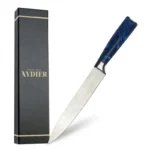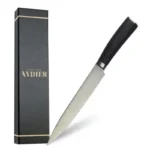Slicing Knives

Precision Cutting with a Slicing Knife
A slicing knife is a kitchen essential for anyone who values clean, even cuts of meat, poultry, or fish. Characterized by its long, narrow blade and slightly rounded tip, it is designed to glide smoothly through food with minimal resistance. Unlike a chef’s knife or a Santoku knife, which are multi-purpose tools, the slicing knife has one main goal: creating thin, uniform slices without tearing the fibers of the food. This makes it especially valuable when preparing dishes where presentation and consistency matter.
How a Slicing Knife Differs from Other Knives
Many cooks wonder about the difference between a slicing knife and a carving knife. While both are used for cooked meats, the slicing knife is thinner and more flexible, giving it the edge in precision work. Its design allows you to cut closer to the texture of the food, which is why chefs often reach for it when working with roast beef, smoked salmon, or even delicate fruits. A carving knife handles thicker, sturdier cuts, while the slicing knife excels in creating fine, graceful portions.
Choosing the Right Size and Material
Slicing knives are usually between 8 and 14 inches in length. Shorter blades may feel easier to handle, but longer ones allow you to cut larger roasts or hams in a single smooth motion, avoiding jagged edges. The choice of material also makes a difference. High-carbon steel blades are known for their sharpness and edge retention. Stainless steel offers excellent durability and resistance to rust. Damascus steel combines strong performance with a patterned finish that reflects traditional craftsmanship. Each option has unique strengths, so the right choice depends on your cooking habits and how much maintenance you prefer.
Practical Uses Beyond Meat
Although most often associated with roast dinners, the slicing knife is versatile enough for other kitchen tasks. It can easily handle fish such as tuna or salmon, making it useful for both Western and Japanese-inspired dishes. It is also practical for cutting large fruits and vegetables where clean slices are preferred, such as melons, pineapples, or cabbages. By using a slicing knife instead of a chef’s knife, you reduce pressure on the food and achieve straighter, more controlled cuts.
Care and Maintenance for Longevity
Proper care helps your slicing knife stay sharp and reliable for years. Honing on a regular basis keeps the edge aligned, while sharpening with a whetstone restores its cutting precision. Hand washing is always recommended to protect the blade. For storage, choose a knife block, a magnetic strip, or a protective sheath to prevent unnecessary wear. With the right attention, a slicing knife can remain one of the most trusted tools in your kitchen.

